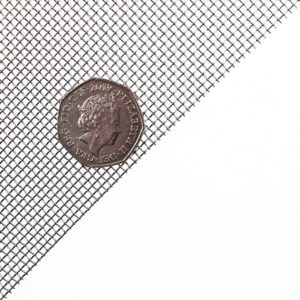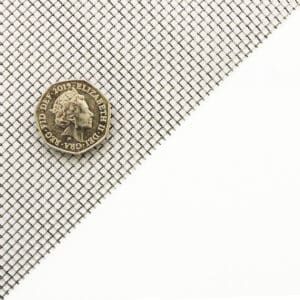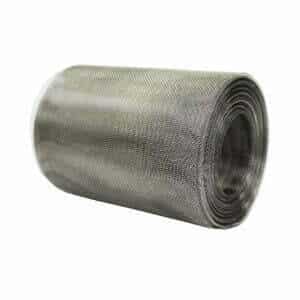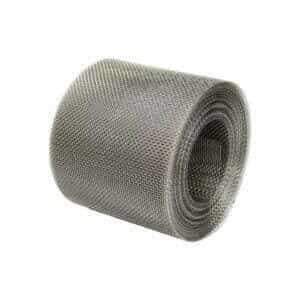







£11.99 – £349.99 inc VAT


This website is secured:
✔ The UK’s Largest Range Of Mesh Products
✔ FREE UK Delivery Included
✔ Immediate Express Dispatch From Stock
✔ Tracked Delivery with Order Updates
✔ 30-Day Returns Accepted
£ Check Out Our Clearance Listing For Savings
@ ☏ Bespoke Sizes & Larger Sheets Available
The woven wire cloth mesh, made from durable 304 stainless steel, mimics the feel of a delicate fabric. Featuring 270 holes per linear inch and a total of 72,900 holes per square inch, it has a wire thickness of 0.036mm and an aperture of 0.058mm. With a 38% open area, this mesh is easily adaptable, able to be cut with standard kitchen scissors or torn by fingertips, making it ideal for various applications from filtering to decorative uses.
0.058mm hole stainless steel woven wire cloth mesh material in top quality 304 grade made from 0.036mm wire. As you can see from the image, this is a fine mesh specification. The holes are very small and not especially visible by naked eye. It is of interest to anyone who needs a fine mesh for any application. You would be able to bend and fold this mesh by hand very easily.
The woven wire cloth mesh is a precision-engineered material constructed from 304 stainless steel, ensuring durability and resistance against rust and corrosion. Designed with a fine weave, it closely resembles the texture and feel of a delicate fabric. Each linear inch of this mesh boasts 270 holes, leading to a substantial 72,900 holes per square inch. Despite its intricacy, the wire has a thickness of 0.036mm, paired with an aperture or hole size of 0.058mm. This configuration results in an open area percentage of 38%, striking a balance between transparency and material coverage.
A notable convenience is its adaptability to size adjustments; it can be easily cut using standard kitchen scissors or simply torn to the desired size using fingertips. This makes the mesh versatile for a range of applications, from filtering to decoration.
The specifications of this woven wire mesh are as below:
Wait!! Before you order your mesh please first check out our clearance listing which is where we put all of our over-run bargain rolls at reduced prices. You never know, you might find just the roll that you need for your purposes.
We also offer a massive range of 304 stainless steel perforated metal sheet options from immediate stock. In order to produce stainless steel perforated metal sheet, flat sheet metal is punched with round or square holes. Perforated sheets are commonly often used in applications where the passing of air is required. Because the holes are punched, it is possible to have a far stronger finished metal product than it would be for the equivalent thickness in woven or welded mesh.
Our group have been in the mesh industry for over 150 years. We are one of the UK’s most trusted mesh suppliers because:
The Mesh Company has an enormous range of woven wire mesh products. We truly are an industry leader among suppliers of weld mesh and woven wire materials. With the capabilities we have in-house, we can provide virtually anything you require.
Copper, brass, black, and galvanised steel wire mesh materials are also available in large stock quantities at bargain prices. See our blog for specific information on all of our various woven wire mesh materials.
This mesh has 270 holes per linear inch. This equates to 72,900 per square inch. This is a very fine mesh.
The production of woven wire cloth mesh, especially when done on an electric loom, is a sophisticated process that ensures precision and consistency. Here’s a brief overview of how the woven wire cloth mesh is produced using an electric loom:
A full roll of woven wire mesh in usually 30 metres x 1.2 metres. Rolls are stocked on our extensive shelving in that format.
Yes, the woven wire cloth mesh can indeed be sewn or stitched, but it requires a unique approach compared to traditional fabric. Due to the wire’s thickness, it’s essential to use a strong needle, typically designed for heavy-duty materials or leather. Due to the metal nature of the mesh, a robust thread, such as nylon or waxed cotton, is recommended. If using a sewing machine, settings should be adjusted for thicker materials, including reducing speed and ensuring the machine’s foot can handle the mesh’s thickness. The needle may need to be pulled through with pliers when hand stitching. By keeping the mesh flat and maintaining consistent tension throughout the process, its structure and appearance will be preserved.
Check out our blog ‘everything that you need to know about woven filter mesh’ for more information on this product. Our goal for our blogs and help guides is to answer as many questions as possible to help to explain the possibilities of mesh to our customers. Contact our team today if you have any questions at all. We are always really keen to help in any way that we can.
You may also be interested in our blog about hardware cloth. This article explains the term in great detail.
We also offer similar products through our highly popular eBay store, check us out there too.
| Woven Mesh Sheet Size | 150 x 150mm x 2 Pack, A4 x 4 Pack (210 x 300mm x 4 Pack), 300 x 300mm (30 x 30cm) Sheet, A3 x 3 Pack (300 x 420mm x 3 Pack), 500 x 500mm (50 x 50cm) Sheet, A2 420 x 594mm (42 x 59.4cm) Sheet, A1 594 x 841mm (59.4 x 84.1cm) Sheet, 1000 x 500mm (100 x 50cm) Sheet, 1000 x 1000mm (100 x 100cm) Sheet, 5 Metre x 1000mm (1 Metre) Roll, 10 Metre x 1000mm (1 Metre) Roll |
|---|
In 2008 Locker Wire Weavers launched The Mesh Company to bring our enormous range of wire mesh products to the general public for the first time. Previously wire mesh was only available for trade customers.
We continue to extend our range, and now proudly offer many forms of mesh and metal products for the best possible prices. We specialise in woven wire mesh. As a group we work closely with architects and designers to develop ground-breaking new applications for our multifunctional range of materials. We also offer state of the art fabrication and engineering for projects of all sizes.
Strong ties with the Warrington community continue to be at the very core of our business. We are proud to invest in the training and developing our staff of all levels in line with the traditions set by Thomas Locker, who founded our group 150 years ago when he invented the electronic loom. We continue to bring ingenuity and strong ethics to our day to day business.
The Mesh Company continues Warrington’s historic role in the wire industry. For more than 140 years, our group has been a leader in the supply and manufacture of woven wire mesh and wire cloth. Having been founded in Warrington, UK in 1878, Locker mesh products still retain the quality craftsmanship and spirit of innovation that were so characteristic then.
Available Options
You will find full rolls of this insect netting here. Please be advised that the majority of woven mesh is usually available in a maximum roll size of 30 metres by 1200mm. Please email us if you wish to discuss purchasing this mesh in any size – sales@themeshcompany.com.
Feel free to call us if you wish to discuss any of our products – (+ 44) 01925 406 602. We are always happy to help in any way that we are able to.
We also offer this product through our highly popular eBay store, check us out there too.




The largest range of wire mesh, chicken wire, wire fencing, woven wire mesh and perforated metal products in Europe, delivered direct from our Warrington warehouse.




Website by: Beech Web Services | Terms and Conditions | Cookie Policy | Privacy Policy | Website Terms and Conditions
Reviews
There are no reviews yet.